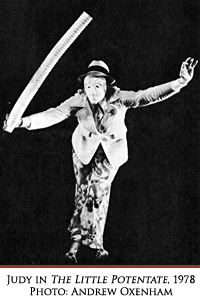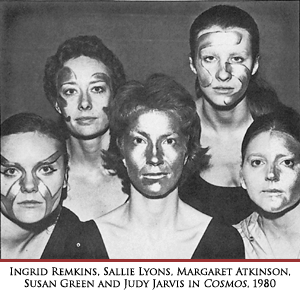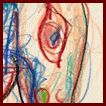 | ||||||||
What her best works reveal is Jarvis' amazing ability to create powerful theatrical images, images that are tight and dearly etched, reverberating images, Noh-like in their economy ... With its primeval creature struggling to free itself from the encrustations that keep it bog-bound, "Dark Animal" projects a sense of tragedy and at the same time of profound hope which leave us breathless. (Read Review) In May of 1979 Judy mounted a season in Toronto at Hart House Theatre. In the late 70s she had begun to invite her Company members to perform certain of their own works on her programmes. This retrospective programme included Susan Rome's Red Mask, as well as Three Women, for which Gina Lori Riley and Pam Grundy returned to perform, Clouds, Shell, Chester, The Hairy Edge and Nuntius. Judy also danced Bella on that programme with Keith Urban. She toured her work that year to the University of Waterloo for the Dance in Canada Conference and to the Niagara Arts Festival at Brock University, St. Catharines. Judy was always worried about money. She was bitter toward the arts councils. Because it meshed theatre and dance, her work was considered borderline -- not really dance as it was expected to look in the mid-to-late 70s. Other Toronto companies of the day were at a consistently higher level of funding. They were developing physically charged virtuostic dance identities while Judy explored her theatrical ideas.
Judy never developed a successful way of sharing responsibilities with an administrator. She was always a loner, and she mistrusted management. One of her managers ran off with the money budgeted for a Company tour. Managers came and went -- none coming near the depth of her on-going commitment to her artistic work. The lack of luck or trust led to uneven management which no doubt affected the way she was regarded by the arts funding agencies. Inevitably, first out of principle and later out of circumstance, Judy did not build a lasting dance house. Her true interest was always in the moment and in creation. In support of her vision, she looked after all the technical and administrative details of her Company's needs by herself. She turned to extensive work in the schools in her last years of dance activity, initiating innovative projects in public schools through the Ontario Arts Council's Creative Artists in the Schools programme. She developed imaginative programming for young audiences, touring her work through Prologue to the Performing Arts. One such show was her 1979 production of Pierre Gynt, which toured in Ontario through Prologue, as well as being toured to the Maritimes and presented at St. Paul's Church in Toronto. Another was Cosmos. Based on Carl Sagan's popular book Cosmos about the origins of the universe, Judy and members of what was to be her last creative Company - Margaret Atkinson, Sallie Lyons, Ingrid Remkins and Susan Green - developed this meditative work. It was toured extensively through Prologue to the Performing Arts from 1981 to 1983.
She saw "amazing and wonderful things" -- Hanya Holm's work at Riverside Church, Anna Sokolow's work, the opera, Louise Nevelson's sculpture, the Museum of Modern Art. She breathed it in. A keen and intuitive observer of visual arts, she could reveal and illuminate the essence of a painting in a few words. The freedom to observe and let impressions sift through her, nourished and sustained her. She was spending more time drawing as she moved away from her years of immersion in dance. She studied visual art over the years in Toronto, Switzerland, in New York City, but as was her way, spent a great deal of time teaching herself and grappling with concepts until she understood them. Her paintings show a concern with emergent shape and geometry. The energies are complicated, an electricity of colour and movement, studies which press at the edges of the paper or canvas. It was a way of communicating as natural to her as speaking. But her artwork was a reservoir, too, at times, for her despair. At the end of the 1981 season two dancers gave notice, igniting Judy's angry feeling of betrayal. In her rages, recall dancers who worked with her, there was always projection of her own insecurities, jealousy about the shape of other people's lives, and a fundamental desire for the dancers not to lose the spirit of dance. Her work and time were precious -- she could never fathom letting them go. Judy's funding was cut off by the Canada Council in the early summer of 1981. But she carried out plans to go to the Edinburgh Fringe Festival. There, she and Susan Green performed a two-woman version of Cosmos. Afterward they travelled to Findhorn, a spiritual centre in Scotland, and then to Paris. Judy went on to the south of France, visiting Aix-en-provence and Paul Cezanne's studio, and climbed Mont St. Victoire. Prologue tours consumed that fall, and Judy began to work toward a production of Catherine the Great, which she had long dreamed of doing. (Next Page) ©2005, Dance Collection Danse | ||||
 Judy could still have chosen to be a powerful solo artist but didn't. Feeling betrayed, tired, poor, she might have been happier without the heartaches and headaches that company life seemed to bring her. Many felt that Judy was at heart a soloist, but she craved the stimulation of companies. Judy confessed to various confidantes that she would have been too lonely working on her own. She had a hunger for creative exchange and was happiest when she was creating. She needed people around her to do it.
Judy could still have chosen to be a powerful solo artist but didn't. Feeling betrayed, tired, poor, she might have been happier without the heartaches and headaches that company life seemed to bring her. Many felt that Judy was at heart a soloist, but she craved the stimulation of companies. Judy confessed to various confidantes that she would have been too lonely working on her own. She had a hunger for creative exchange and was happiest when she was creating. She needed people around her to do it.

 Judy was still finding sustenance in trips to New York. She travelled there in the spring of 1981, studying yoga, and taking ballet and stretch classes at Finis Jhung's popular studio. Her health was not good. She had sporadic serious back problems, severe asthmatic reactions and occasional bouts of pneumonia.
Judy was still finding sustenance in trips to New York. She travelled there in the spring of 1981, studying yoga, and taking ballet and stretch classes at Finis Jhung's popular studio. Her health was not good. She had sporadic serious back problems, severe asthmatic reactions and occasional bouts of pneumonia.




